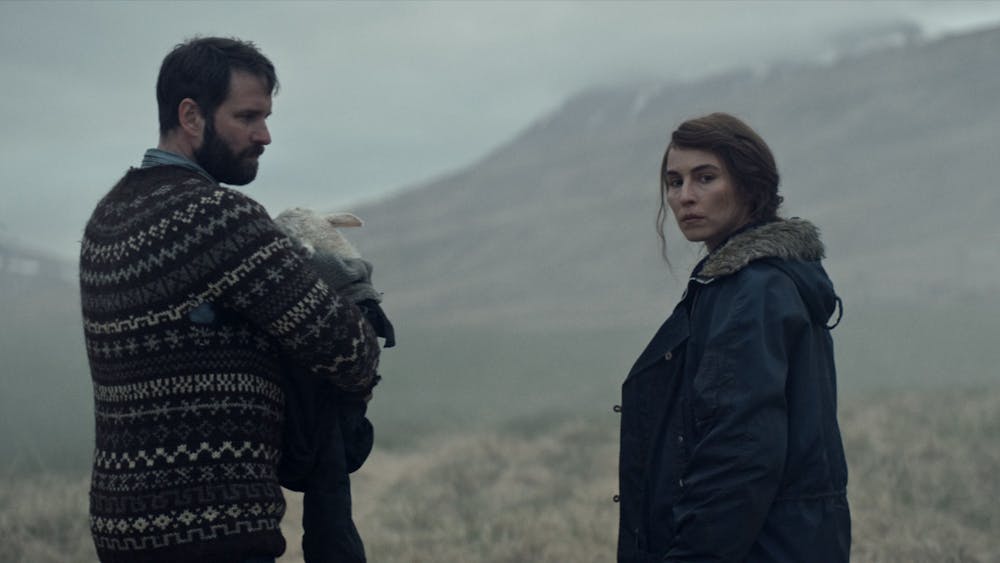From: Silver Screen
REVIEW: A sheep in human’s clothing? ‘Lamb’ takes anthropomorphism to a whole new level

This review contains spoilers for “Lamb.”
Coming off of an ambitious summer, A24 connoisseurs should expect nothing less than daring decisions in the studio’s latest: Valdimar Jóhannsson’s debut feature, “Lamb,” which premiered at Cannes Film Festival and took home the award for originality.
As we travel to Iceland, the film takes us to a secluded and timeless valley filled with foreboding fog, imposing inclines and oddly, hybrid human-sheep.
Opening with the point-of-view of a heavy-breathing figure, viewers are ushered through a grayscale world enshrouded in an opaque fog and howling wind at a measured pace. This slow-burn tempo carries throughout the majority of the film, contrary to the promised jump-scares and violence of the film’s trailer. There’s an added tension of silences lasting for long periods of time with only strangely emotive baa-ing to fill the space. Moreover, the pervasive sunlight of the northern hemisphere never allows for any seclusion or veiling of the action, a tactical reversal of the horror tropes that A24 films usually embrace and execute masterfully.
The film follows shepherds Maria (Noomi Rapace) and Ingvar (Hilmir Snær Guðnason), a childless married couple living alone in the middle of an unspecific Icelandic valley. Their location serves as a remote and seemingly magical place of opportunity and strife for the couple, who make a shocking discovery: one of their sheep has given birth to a half-human, half-sheep baby. The film does not dwell on the specifics of the science of how this happened, but rather the emotional ramifications of this defiance of nature.
Reflecting its fairy tale and folklore aspects, the film is divided into numbered chapters that center on relatively distinct conflicts. Chapter I cleverly hides the truth of the couple’s fascination with this specific lamb, Ada, until the reveal of her literal half-human and half-sheep features.
Chapter II focuses mostly on Maria, who, while sharing the name of a supposed archetypal figure of motherhood, proves unstably jealous of her child’s sheep mother. She eventually kills and buries the child’s sheep mother in a violent fervor, along with an unsettling long burial sequence empathetic to the slaughtered ewe. Ingvar’s brother, Petur (Björn Hlynur Haraldsson), arrives and immediately escalates the tension with the couple’s newfound domestic “happiness,” and his persistent romantic interest in Maria.
One of the main takeaways was Jóhannsson’s unique ability to create suspense. While much of the film is slow-moving and character-driven, Chapter III constructs a nail-biting, unsettling feeling that only swells in the film’s final moments. Contrasting intercut images — Maria, Ingvar and Petur dancing around the house drunk juxtaposed by Ada looking at herself in the sheep-barn mirror — spawns growing questions at the seemingly lackadaisical lack of resolve to the mounting tension.
The titular promised focus on sheep seems muddled, as we do not see the domestic relationship between the couple and their flock after Chapter I, but for an eerie gathering of some tougher-looking, horned sheep interposed within the action of Chapter III. Finally, after Maria rejects Petur’s sexual advances and persuades him to leave, the climax of the film grows to a point: in an intense shoot-out scene by a minotaur-esque sheepman, Ada utters her first and final word: “Dada.” Closing on Maria’s screams and searching after she finds Ingvar’s body — powered by a searing performance by Rapace — the film offers no explanations, just the notes of Haendel’s “Sarabande.”
As much as it contains suspense and considerable shock value facilitated through clever cinematographic tricks and strategic withholding of information, it is hard to gauge whether or not the film has something more to say in its portrayal of modern animal husbandry and its definitions of what it means to be a human, or worthy of being raised as such.
While the sheep-herding tradition remains important in Icelandic culture, what does it mean to have an animal-human relationship literalized into a complex, emotional psycho-thriller, especially when anthropomorphic or humanoid sheep are not recognizably Icelandic folklore? Jóhannsson’s intentions are unclear, especially with his probable warning about mistreating animals. However, his incorporation of meta elements, such as the characters watching movies and reading books about folklore and magical realism, suggests a deeper lesson or meaning to be grasped, as most fables provide.
Granting the multitude of interpretations anthropomorphism offers, “Lamb” still provides an extenuated, suspenseful and at times voyeuristic exploration of a very niche subset of society unfamiliar to international audiences.
“Lamb” was released in theaters on Oct. 8, 2021.




